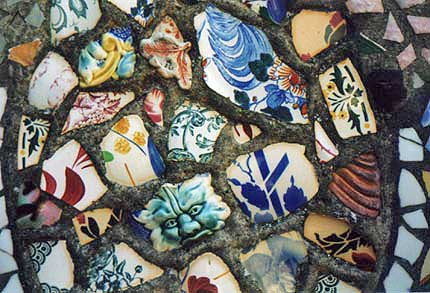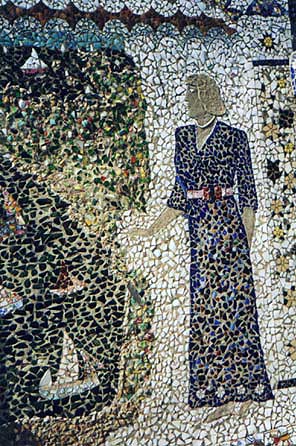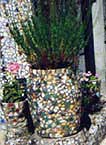 |
Raymonde Isidore made dozens of concrete planters, decorated with pieces of broken china, and on the front wall (facing west) are two prominent mosaic pictures of vases of flowers. The outline of the vases is provided by the sharp lines of the background, and the style falls halfway between his abstract, decorative mosaics and his intricately detailed pictorial images. The blooms themselves are made up of simple flower motifs, splashes of coloured china and crockery with floral patterns already painted on it. The effect is to combine folk art, impressionistic colour and collage. It leaves me wondering if these are really pictures of Isidore's own planters, the shards of crockery representing the actual pieces of broken china on the planters!
|
 |
A detail of a vase |
 |
This mosaic mural is on the south wall of the house. It incorporates two recurring themes: travel (and exotic locations, although this seems to be the Bay of Biscay) and the figure of a woman. The sailing boats are exquisitely executed. For the smaller boats a single piece of white crockery depicts the sail, much as a deft brush stroke would do in a painting. The woman's head and neck are carved in cement. Raymonde Isidore is famous for his mosaic, but he also was capable of delicate and skilful work with carving cement, presumably before it had fully set. He often used touches of this technique in combination with mosaic, for example to emphasise a line or to add relief, but some works are very fine in their own right. The name Isidore was given, "Picassiette", comes from the French phrase "pique-assiette". This means "a scrounger" and as far as I know would not generally be considered a compliment. It is also perhaps a pun on "Picasso". We think of Picasso as a famous artistic genius, but it is worth remembering that in post-war provincial France, his paintings were regarded by many as shocking and controversial. To be compared to him was, again, possibly not a kind comment. Whatever the case, Isidore, and his wife, embraced the name, and La Maison Picassiette was well known during their lifetime. |
|
Further along the house wall in a corner with one of the outbuildings is this abstract collage of broken figurines, cup handles and bases and other three-dimensional bits and bobs. The areas around it are separated by different colours of cement. The asymmetric 8-pointed star is vivid and uncomfortable, emphasising the variety of Isidore's work.
|
 |
the joy of shards Mosaics Resource

